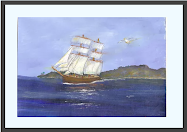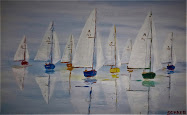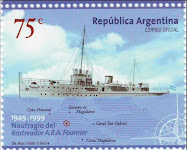The "Thomas W. Lawson" was a seven masted steel schooner designed by Bowdoin B. Crowninshield and built by the Fore River Ship & Engine Building Co., Quincy, MA, in 1902.
She was
Bound for London loaded with oil she was caught in a storm off the Scilly Islands on the 13th of December 1907. It was decided to try to anchor, but during the night her anchor chain broke and she stranded on the Scilly Islands.
La Thomas W. Lawson, construida en 1902; tenía siete mástiles, era de acero y su capacidad de carga superaba las 5.000 toneladas.
EL SINDROME DEL THOMAS W. LAWSON
Richard Foster, comenzó su excelente libro innovation: The Attacker´s Advantage de la siguiente manera:
El esfuerzo agónico por negar el adelanto de la tecnología era inútil. Obviamente y como observó Foster: “la edad de los barcos de vela comerciales terminó con el Thomas Lawson. Y los barcos de vapor comenzaron a reinar en los mares”.
Al impedir que los gerentes descarten las viejas tecnologías y adopten las nuevas, el Síndrome del Thomas Lawson evita que las organizaciones rompan el status quo y miren mas allá hacia el fu

Job: Bulk Oil Carrier
Tonnage: 5218 tonnes
Date of incident: 13 December 1907
The boat was named the Thomas W. Lawson, she was built in Boston for the transpacific trade links but was later converted to carry oil in bulk across the Atlantic. She was the only seven mast schooner ever built, her masts named Sunday, Monday, Tuesday, Wednesday, Thursday, Friday and Saturday; there had been nothing similar before and there has been nothing similar since.
She was of gargantuan proportions of her day, she weighed in an a staggering 5218 tonnes and was valued at $400,000. Because of her unique enormity, she was sluggish and difficult to manoeuvre, especially when carrying her 60,000 barrels of oil.
This was the case, when on the 13th of December she sailed straight amongst the Western Rocks just west of St Agnes when she mistook the bishop rock lighthouse for a passing schooner.
Her life raft and lifeboats had been rendered useless in the terrible seas she encountered crossing the Atlantic, so the only course of action to take was to lay anchor and ride out the storm as her size and the conditions prohibited any manoeuvre to get clear of the Islands.
The Captain of the Lawson refused to leave his boat and there was nothing the St Agnes crew could do for the boat.
Eventually it was agreed that a Local Pilot would be put aboard, William Cook Hicks, and a signal was agreed; if the boat got further into trouble, a flare would be lit on deck.
By this time, the St Mary's boat had returned home after sustaining damage to her mast when it got trapped under the Lawsons’ quarter. She was instructed to return to St Mary's for repairs and also organise a tug from Falmouth to come over to the Islands.
The St Agnes boat then returned home with a sick crew member A watch was kept from St Agnes lighthouse to look for many signs of the signalled. At this point the storm was still raging and at about 3:00 am, the lookout reported that a terrible squall had hit and the light on the Lawson has gone out. It was presumed that the reason for this was the the terrible weather had put out oil lamps aboard. No flare was ever seen. Within the hour, the stench of oil had engulfed the islands in a blanket that signalled disaster for the lifeboat crews. The ensuing tragedy was anticipated by the St Agnes crew, whom gathered at Perigless before dawn, ready to launch the gig ‘Slippen’.
l 13 novembre 1907 partì da Filadelfia per Londra carico di due milioni di galloni di petrolio.
Il 13 dicembre 1907 fu preso in una successione di tempeste con vento talmente forte da spingere il bastimento a 12 nodi senza vele.
Giunto in prossimità delle Isole Scilly, si ancorò al largo in attesa della calma ma nella notte si spezzarono le catene delle ancore ed il bastimento, spinto dalle onde, si arenò davanti alla scogliera di Hellweather nelle Isole Scilly.
La nave fece naufragio. Persero la vita tutti i membri dell'equipaggio salvo due: il comandante Cap. George Dow ed un marinaio, Edward Rowe.
EN LA PRENSA DE ENTONCES.
From The Western Weekly News, 21st December, 1907
DISASTER AT SCILLY
American Sailing Ship Lost
Seventeen Men Drowned
Wrecked at Scilly
‘The Western Morning News’
Sea Tragedies
Largest sailing ship lost off Isles of Scilly
St. Agnes pilot goes down with ship
Survivors’ Sufferings
The wreck of a huge American sailing ship at the Isles of Scilly, involving the loss of many lives early Saturday morning (Dec. 14), augments the dreadful toll the seas have claimed. The story of how the largest sailing ship in the World was cut in twain among the rocks reveals a harrowing story of fate of those who went down with the Thomas W. Lawson, and of the three men who survived her until Sunday, when one of those failed to escape death. The doomed vessel was seven-masted and schooner, and the biggest sailing ship afloat. She belonged to Boston, Mass., U.S.A. and was built five years ago of steel, and was constructed especially to save labor in crew. She only carried a captain and crew of seventeen, Captain George W. Dow of Boston was her master, and she sailed from Philadelphia on November 20th last. The ship was valued at 400,000 dollars, and her cargo was worth approximately 200,000 dollars. The cargo consisted of oil, and it was computed that in bulk there were about 60,000 barrels. Her net tonnage was about 5,000 tons. From the start the vessel had a bad passage. In the words of the captain, it was blowing something wicked last Monday, Tuesday, and Wednesday week. She ran into a southerly gale and fared badly. Half the sails were blown away and a lifeboat and life raft lost, only a 20 ft. boat remaining. The whole of the deck fittings were smashed, including hatches and the cabin door, whilst the ship herself was badly strained.
The Thomas W. Lawson weathered that storm, only to meet as violent a one. On Friday last she made the Isles of Scilly, and the captain found he was too far to the leeward by a mile. There was no room to wear ship, and there was not sail enough to tack. The ship was, therefore, brought to and anchored. Her position was dangerous. She was in waters teeming with rocks and submerged ledges, between Nun Deeps and Gummers’ Ledge and in Broad Sound. This is inside Bishop Rock Lighthouse, which was first reported on the ship as a passing schooner. The Thomas W. Lawson, with two anchors out, faced the fury of a fierce northwest gale. Accompanying the gale were mountainous seas, and the ship could not have been in a worse position. She had been sighted from St. Agnes and St. Mary’s Islands, and realizing her extreme danger, the St. Agnes lifeboat was launched. The keepers on the lighthouse also saw her and fired signals. St. Mary’s lifeboat was being manned and launched at 4:25 by order of Mr. E. J. Bluett, Hon. Secretary of the local branch of the lifeboat institution. Both lifeboats had trying experiences as seas continuously broke over them. The St. Agnes boat was launched about four o’clock and reached the ship shortly after five. The captain was asked if he wanted assistance, and replied in the negative. Knowing the danger in which the vessel stood, the lifeboat men again asked, and got alongside. Captain Dow then requested the services of a pilot. One of the lifeboat crew, William Cook Hicks a well-known Trinity pilot went aboard, but all that could be done was to wait for moderation of weather. The lifeboat stood by the ship. St. Mary’s lifeboat afterwards arrived, and in attempting to get alongside, got under the quarter of the vessel and carried away her mast. She returned to St. Mary’s to repair the damage and to send telegrams to Falmouth for tugs. The reply from Falmouth was that the tugs left at 10:20 on Friday night. The tugs never arrived, evidently finding the gale too fierce to face. The St. Agnes boat had to leave the ship in order to take ashore one of their crew who had suffered from exposure. It was feared he was dead, but restoration was brought about when he was taken ashore. Hicks, the pilot on board, was informed, and told that should anything untoward happen he was to burn flare. Neither of the lifeboats went back. A sharp lookout was kept from various points. At 2:30 on Saturday morning the ship’s lights disappeared. As the gale had heightened, it was thought at St. Agnes that the lights had been accidentally extinguished. Little did the watchers realize that the Thomas Lawson had gone to her doom, and that of the nineteen souls aboard, including one of their own mates, only three were at that time struggling from death to tell the tale of the tragic fate of the ship.
How the Ship met it’s Fate
The Thomas Lawson broke an anchor, unable to stand the hurricane, and, dragging the other, crashed into the rocks. The officers and pilot were in the mizzen-rigging lashed between two and three o’clock, and the remainder were scattered in different parts of the ship, the chief on the forecastle head. The ship struck broadside on, smashing in the starboard side, and causing rigging to sag until the seven masts began to sway with the motion of the vessel as she was buffeted by huge seas. It was a desperate and awful time. The engineer, Edward Rowe of Boston, was by the side of the pilot, and when the huge craft trembled from end to end as she was hurled against the rocks, he asked Hicks if there was a chance of getting ashore. Hicks knew every inch of that treacherous part, and replied, “No”. But strangely enough, that engineer is one of the survivors. Hicks, to the regret of all Scillonians, is missing, and is undoubtedly dead. The end of the ship came swiftly. She only struck once more, and then came destruction. Masts and rigging crashed into the sea, and the stem was cut right off. The cargo was freed, and thousands of gallons of oil poured out onto the sea. Every man had a life belt, but nearly all were either dragged down in the rigging, dashed against rocks, or perished in the horrible floating masses of oil.
The Survivors’ Terrible Plight
Out of the vortex came Captain Dow, Rowe, the engineer, and George Allen of Battersea. They had terrible hardships to pass through before finding a refuge on the rocks. Terrible privations followed in full exposure to the awful weather. For many hours those on the islands were still watching, ignorant of what had happened. Daybreak revealed no ship, but the almost overwhelming stench of oil told its own story. The lifeboat was not launched, the weather being too fearfully rough, and it was not thought advisable even to try to get her out at St. Agnes. The grownup son of pilot Hicks pleaded for an endeavor to launch the lifeboat when the lights of the ship disappeared. At daybreak, a crew volunteered to go out with a gig, and eight young St. Agnes men, including pilot Hicks’ son, heroically launched it. They landed on the uninhabited island of Annet, and then heard the faint shouting for help. A search revealed the sailor, Allen, suffering from exposure and internal injuries, trying to get shelter beneath a rock. He had been weathering the storm on the same shore as three of his mates, but they were dead. He saw them at daybreak, and evidently there was life in them then. He urged his rescuers to go to them as he was all right. Allen was borne to St. Agnes Island and placed under the roof of a hospitable farmer, Mr. Israel Hicks. Communication was set up with St. Mary’s, and St. Mary’s lifeboat took Dr. Brushfield to St. Agnes, and he attended the injured man. The doctor did not regard his recovery with any hopes. Allen was then apparently the sole survivor, and he had been taken from an island two miles from where the vessel had anchored and was left by lifeboats. Allen had been on the island about five hours, and was the last man washed off the vessel. The islanders almost gave up hope that any other man could be living on the rocks in the vicinity.
The Captain Rescued
The same crew, however, made another brave row to Annet Island, leaving St. Agnes about 2:30 Saturday afternoon, and they were rewarded by finding a man safe and well. On their way they saw the engineer on a rock at Helwethers Carn. They threw him a rope, and with its aid, he got through the surf and into the boat. Rowe then told them that the captain was on the rocks there helpless. How he got there, he did not know, but he discovered him in the night and dragged him up into comparative safety. Rowe himself was badly battered and suffering through swallowing salt water and oil. They took him ashore and went back to rescue the captain. Captain Dow undoubtedly owes his life to Fred Cook Hicks, a son of pilot Hicks who has not been found. They could not effect a landing, and Hicks thereupon took the rope and swam and scrambled through nearly fifty yards of sea and rock. His difficulties were not then over, as he found the captain helpless with wounds he had received through being tossed about, and with a broken wrist. Hicks securely fastened him with a rope, and managed to get him to the gig. Captain Dow was taken to the same house in which Allen and Rowe were sheltered and was attended, Dr. Brushfield being again taken out by the St. Mary’s lifeboat, and the lifeboat men searched the rocks to try and trace other men of the ship. On Sunday morning the St. Mary’s lifeboat and numerous gigs from the different islands made an examination of the rocks in the neighborhood, and recovered the headless body, it is believed, of one of the officers, and later the fifth body.
Death of Allen
Allen died on Sunday afternoon, so that the only survivors are the captain and the engineer. It is understood that the ship is not insured. Captain Robertson, one of Lloyd’s special surveyors, on Sunday morning went from Penzance to the Isles of Scilly on the Western Marine Salvage Co.’s boat, Lady of the Isles, with Captain Anderson, the well-known wreck-salver to inspect the position of the vessel. They visited the scene, and found at high water that it was not visible.
Bodies Recovered
Five bodies have been recovered. Three have been identified, those of Mark Simpson, cabin boy, Brooklyn: George Bolimke, seaman, a German: and Victor Hansell, a Swede. From one of the other bodies the head and arms are missing.
Description of the Vessel
The Thomas W Lawson was one of the most remarkable craft afloat. She had seven masts, and being entirely fore-and-aft rigged, was described as a schooner, carrying only spinnakers, gaff, topsails, and fore staysails. She was the biggest seven-masted schooner in the world, and had the distinctions of having a larger tonnage and deadweight capacity than any other American-owned ocean-going sailor. Her appearance at sea, when all her sails were set, was extraordinary. Not long ago she was badly damaged in a gale off the American coast. She eventually made her way to port, and only recently was completely refitted for sea. A peculiar item in her equipment was a small steam engine she carried to facilitate the handling of her immense sails, thus enabling her to do with a smaller crew than would otherwise have been required. She was built in 1902 by the Fore River Ship and Engineering Company of Quincy, Massachusetts for the Coastwise Transportation Company of Boston, U.S.A., and was of 5,218 gross tonnage, 5,006 underdeck, and 4,914 net tonnage.
Tragic Stories Related at the inquest
Rescuers Praised
The inquest on the recovered bodies of the wreck of the Thomas W. Lawson was on Monday opened by Mr. W. M. Gluyas, coroner for the islands at the house of Mr. Israel Hicks at St. Agnes in which the captain, the engineer and Allen, who died on Sunday, were sheltered. The Governor of the Isles (Mr. T. A. Dorrien Smith) as well as Mr. E. J. Bluett, hon. secretary of the National Lifeboat Institution: Mr. T. Bradley, divisional coastguard officer: and Mr. Harold Sandrey, representing the American consul.
Lost Pilot’s Son’s Story
Israel Hicks, Trinity boatman, stated that on Friday he and others were out on relief duty at Round Island Lighthouse, and when returning towards evening heard signals fired at Bishop Lighthouse. Then they saw a vessel, which proved to be the Thomas W. Lawson, in Broad Sound. They attempted to reach her in their gig, but failed on account of the weather. When they reached St. Agnes Island, they found that the lifeboat had been launched. At a quarter-past two on Saturday morning he saw the lights of the vessel riding in the Broad Sound, but later he missed them, and afterwards a strong smell of oil pervaded the air. He concluded the ship had been wrecked. On Saturday, after a little difficulty, they got a crew together to man a gig to go to see if they could find any men on the rocks or in the sea, alive or dead, as the ship had disappeared. They left St. Agnes shortly after seven o’clock, and just after landing at Annet found the dead body of a man who was evidently out of the wrecked ship. A quantity of wreckage was strewn about. They divided into parties to search the island. Some of them heard shouting, and thought it came from others of the crew, but they found the man Allen sheltering beneath the rock. He was calling for help. They assisted him to a boat, and a further search resulted in the finding of two more bodies. They brought Allen to St. Agnes, and he was conscious, though in great pain. Allen told him that his aunt lived at Battersea and that he was returning after five years at sea. He died on Sunday afternoon.
Harold Sandrey produced Samson’s pocketbook containing cards inscribed with his name, and the captain identified him as his steward.
Captain Declined Assistance
Wm. George Mortimer, pilot and coxswain of St. Agnes, stated that on Friday afternoon about 4 o’clock his attention was called to a large vessel in a dangerous position. The lifeboat was launched immediately. It was not then blowing hard, but the seas were fairly rough. They reached the stern of the vessel and asked if they wanted assistance, but there was then no reply. To another question, assistance was declined. They told the captain he was in a dangerous position, and again asked if he wanted assistance. His reply was, “I am all right.” She had two cables out but only one was holding. The vessel was then a mile and a half from Annet Head. She was not riding heavily on account of her extreme length. When the captain refused assistance, they decided to go alongside with the intention of trying to persuade the captain to slip the ship and go through Broad Sound. Those on the vessel threw them a rope. The captain asked for a pilot, and Wm. Thomas Hicks, one of the crew, went aboard. As there was too much sea to stay alongside the vessel, they dropped astern where they remained from 5:30 until nine. Several times the pilot came to the stern and shouted to them to know how they were getting on. The ship sent down some bread and coffee.
From American Neptune.
A giant among giants the steel-hulled Thomas W. Lawson was the largest schooner ever built. The schooner also had the distinction of being the only seven-master built. Designed by B.B. Crowninshield, a naval architect better known for his racing yachts, the Lawson was built by the Fore River Shipbuilding Co. of Quincy, Mass. in 1902 at a cost of $240,000. The schooner was named after Boston millionaire stockbroker and yachtsman Thomas W. Lawson.
By all accounts the Thomas W. Lawson was a bad sailor and certainly no yacht. In fact the schooner was such a terrible sailor that someone once commented that the ship handled “like a beached whale.” The schooner carried the remarkable quantity of 43,000 sq. ft. of sail or one acre of sail - more than enough material to make 2,300 dining room tablecloths... and made by the sail making firm E. L. Rowe & Son of Gloucester, MA. Yet even this vast press of canvas was insufficient for driving the ship’s bulky hull through the water and ship was at best a slow sailor. To handle this large quantity of canvas the Lawson had a crew of only 16, aided by a steam donkey engine that drove the hoisting winches and assisted with the steering. Designed as a coal ship for moving cargoes of coal along the East Coast, the LawsonThomas W. Lawson was lost on December 13th the same year, off Britain’s Scilly Isles. While riding out a gale, the anchor chain broke and the schooner foundered on Hellweather Reef with the loss of 15 of the of the crew. could deliver 11,000 tons of coal a trip. The schooner however proved so unhandy that it was refitted for use as an oil tanker to haul oil from Texas to the Eastern Seaboard. Chartered as an oil tanker to the Anglo-American Oil Co. in 1907, the










1 comentario:
Prezado Guilhermo
Parabéns pelo belo post sobre a escuna Thomas Lawson. Pretendo reproduzí-la em miniatura para colocar em uma garrafa. Navegando na internet a procura de fotos encontrei seu blog.
Se puder dê uma passada lá.
Um abraço.
Sergio Nunes
Publicar un comentario